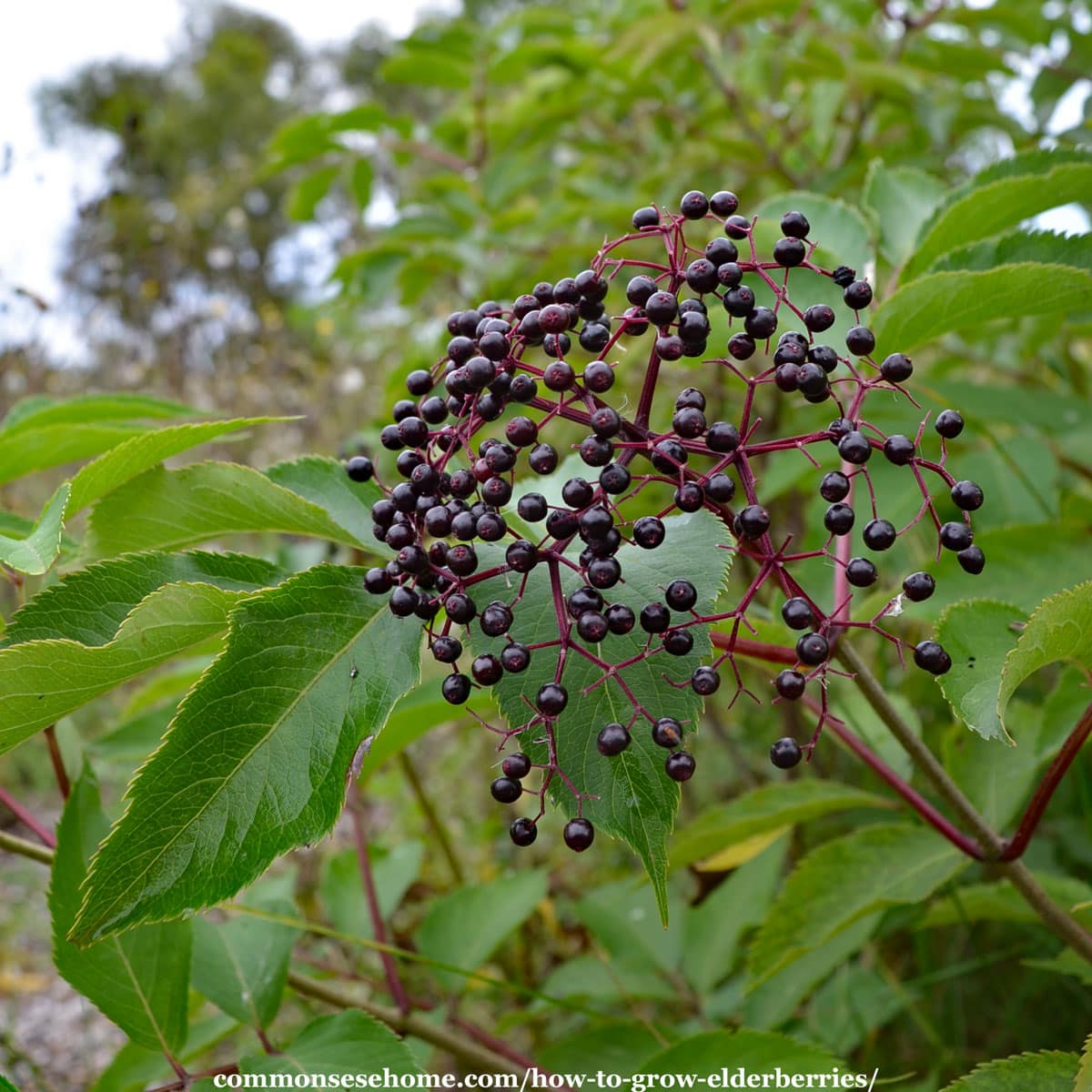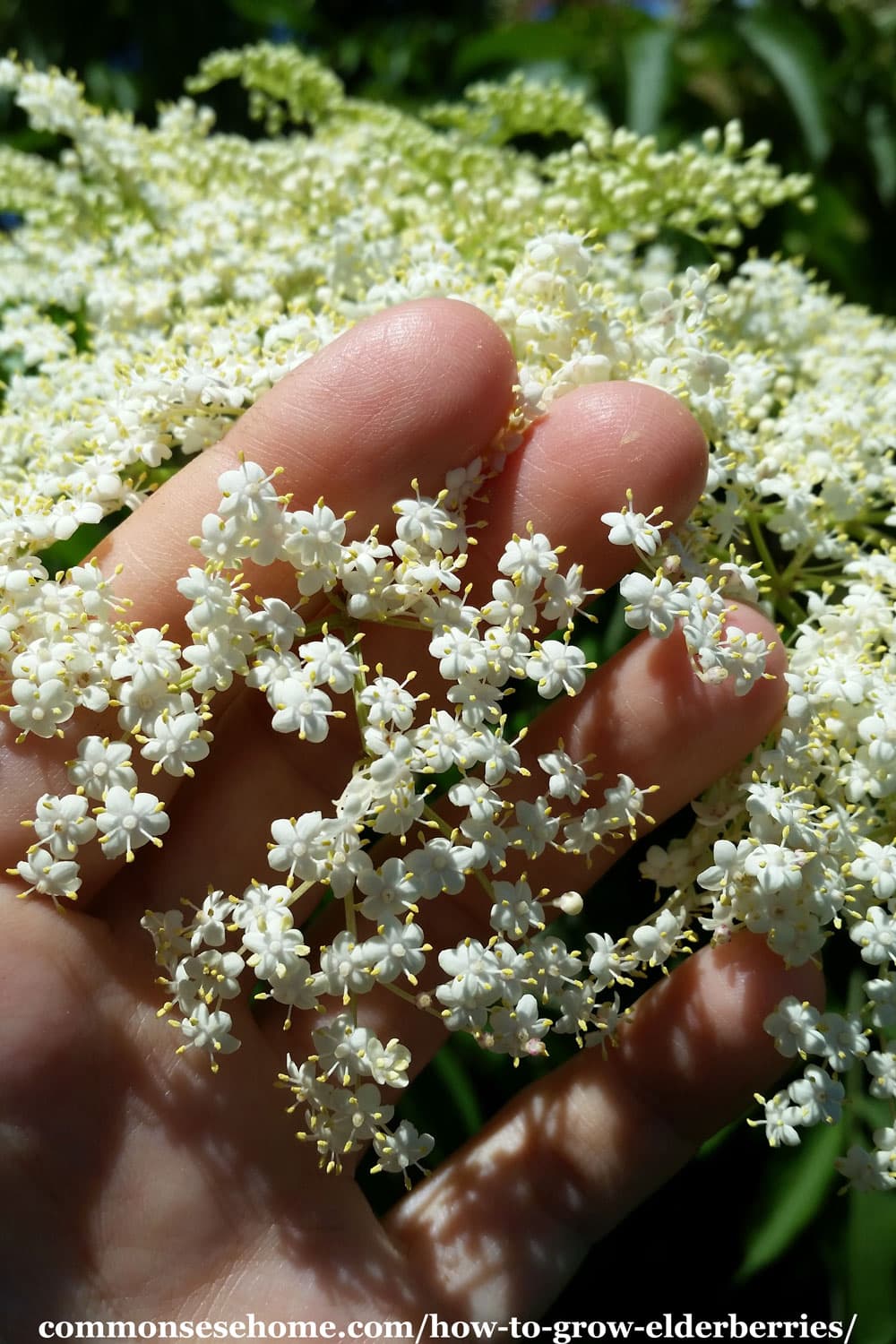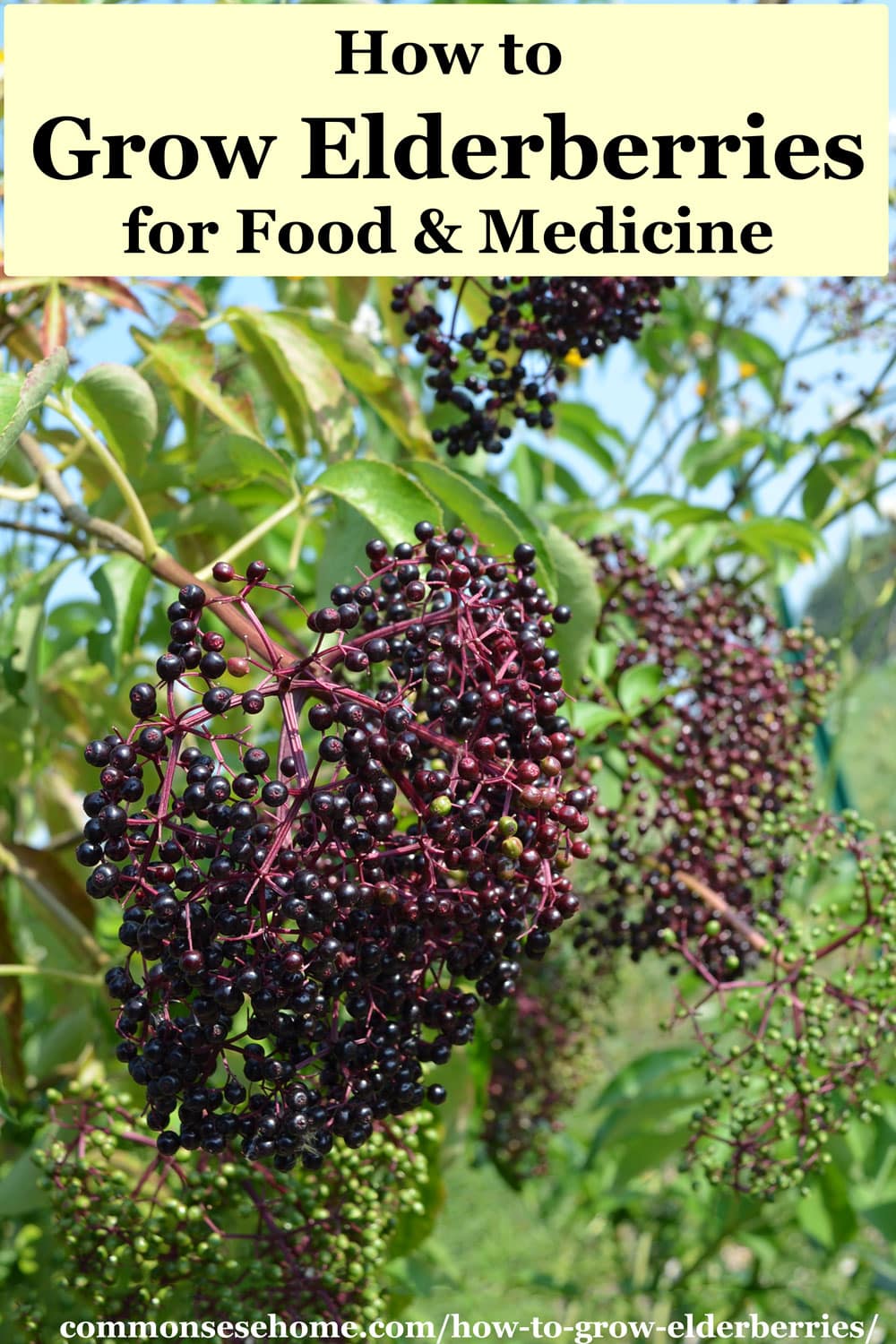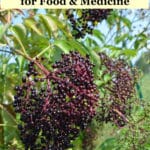How to Grow Elderberries for Food and Medicine
With the right growing conditions, it’s easy to grow elderberries. We’ll help you grow bunches of these superfood berries right in your own backyard.

European Elderberry and American Elderberry
The two most commonly grown types of elderberry are European elderberry (Sambucus nigra) and American elderberry (Sambucus canadensis). European elderberry is also known as black elderberry.
American elder is sometimes known as Sambucus nigra subsp. canadensis. Sambucus canadensis grows throughout the East and Midwest of the United States.
Blue and red elder grow in the west. Blue Elderberry (Sambucus nigra ssp. cerulea) is native to western North America. North American red elder (Sambucus recemosa) is sometimes used for food and medicine, but is more likely to cause stomach upset.
European elderberry grows as a tree or shrub, reaching up to 20 feet tall. American elderberry shrubs typically reach 5 to 12 feet tall.
Elderberry plants produce white flowers in the spring and blue to dark purple berries in the fall. Some of the everbearing varieties continue to bloom all summer.
There are also ornamental varieties that are beautiful but do not produce any significant volume of berries.

How to Grow Elderberries
Elderberry plants grow in USDA hardiness zones 3-9. Elderberries are easy to care for once the plants are established. They bear fruit 2 to 3 years after planting.
They bloom late spring and are ready to harvest in August or September, depending on the zone and variety. Elderberries are partially self-fertile, but for best fruit production, plant another variety nearby.
Elderberry bushes can be both ornamental and edible landscaping. Keep in mind, most elderberry varieties will sucker and spread and create a dense hedge over time.
It is normal for elderberry growth to start slow. They follow the “sleeps, creeps and leaps” growth pattern. After a year or two to get established, they start to spread more vigorously.
When to Plant
Plant elderberries in the late winter or early spring. You can order plants online, or you may be able to find them at your local garden center.
If you are going to try to transplant a wild cultivar, make sure you match the soil and moisture levels.
Dig a shallow hole, 12 to 18 inches deep. Work compost or composted manure into the hole. Bury the elderberry plant or root stock with the base of the stem level with the soil line.
Where do elderberries grow best?
Elderberries prefer full sun to partial shade. Fruiting is best in full sun, but light shade is a benefit in warmer climates. There are varieties available for USDA hardiness zones 3-9.
The plants tolerate most soils, except sand. If you have sandy soil, amend heavily with organic matter. Soil pH can range from 4.5 to 8.5, but 5.5 to 7.5 is preferred. Plenty of organic matter will help your plants to thrive.
Common varieties grow up to 12 feet tall and 6 feet wide, so space them at least 12ft apart. If you want to create a hedge, you can space a little closer, but they need room to grow. For pollination, keep plants within 50 feet of each other.
Remember, plant multiple varieties for better pollination and more berries.

Mulching
Elderberries have shallow roots, approximately 2 inches deep. Mulching reduces weed competition, making it easier for the plants to get established. (Hand weed when needed to protect the roots.)
In spring, top dress plants with compost or composted manure. Then add 2 to 4 inches of organic mulch to protect the roots and hold moisture.
Watering
Elderberries are not drought tolerant. If rains fail, give them one to two inches of water per week. It’s best to water at ground level, and avoid spraying the foliage to help prevent disease.
Elderberries grow on the edge of wet areas, but they won’t thrive in standing water. Mulching helps protect the plants during dry periods.
Fertilizer
Fertilize with 10-10-10 or top dress with manure and/or compost in spring.
Pruning
Cut dead, damaged and crossing wood each spring before budding. If you want to improve production, remove the oldest branches from the plant. Fruiting is normally heaviest on 2-3 year old wood.
Some people who grow elderberries prune the bushes completely to the ground each year. This works if you have a variety that produces fruit on first year growth.
Propagation
If you have existing elderberry plants, you can take cuttings to make more plants. Elderberries have natural rooting hormones, so they are easier to propagate than many other plants.
In the right growing conditions, you may be able to take a cutting, stick it in the ground, and have it grow.
For full instructions on different propagation methods, including cuttings and seed starting, see The Elderberry Book by John Moody.
Would you like to save this?
Elderberry Pests and Disease
Since the leaves and stems are toxic, not much bothers them, but they do have a few pests. Japanese Beetles eat elderberry plants while searching for food they like better.
Spotted wing drosophila, a type of fruit fly, goes after the berries. You can reduce their numbers with fruit fly traps.
Birds like the berries, too, but usually don’t eat all of them if other food sources are available. For smaller patches, bird netting may help.
Deer sometimes eat the foliage and fruit, or use the plants for rubbing. We ended up fencing our patch, as the deer kept attacking the bushes in winter.
Watch out of elderberry rust, a fungal disease. You can identify the disease by the “rust patches” or pustules, and stem twisting. Cutting nearby sedge can reduce the odds of infection.
The plants can also get powdery canker, mildews and leaf spots. Cut and gather infected leaves and branches and dispose away from the plants. Burn diseased plant material to prevent spreading.

Harvesting Elderberries
Most people grow elderberry plants for the fruit and the flowers. Both are edible.
Mature elderberry plants will produce between 3 pounds (1.3kg) and 15 pounds (6.8kg) of berries depending on variety and conditions.
Enjoy the flowers raw or cooked, or dry for later use. Harvest berries when most of a cluster is dark purple, blue, or black in color.
Use a hand shear to clip off entire clusters of flowers or berries. Cut them back to about an inch above the branch junction. Drop the cluster into a collection bucket.
After gathering the clusters of berries, you need to remove the berries from the stems. We usually put a movie on and pick them off while watching. Some people use a large tooth comb to help get the berries off the stems.
To speed up the process, you can freeze the berries clusters first. Remove a small amount of clusters at a time, and smack them against the side of a container to knock the berries off.
Since they are small, the berries thaw quickly, so it’s best to work with a small amount at once. This method tends to get more stem bits in with the berries.
See also:
- How to make Elderberry Syrup with Fresh or Dried Elderberries
- Easy Elderberry Wine Recipe
- Elderberry Jelly Recipes – Traditional and Low Sugar
- Natural Remedies for Colds and Flu
Can you eat elderberries raw?
We don’t recommend it, but a few raw berries shouldn’t be a problem.
The seeds, leaves, stems, and roots contain cyanide-inducing glycoside. Cooking destroys the glycosides, making the berries safe to eat.
Large amounts of raw berries, especially unripe berries, can cause rashes, nausea, vomiting, and diarrhea and other problems. Cook the berries and juice before consuming.

Elderberry Benefits
Elderberry has been used since ancient times as a medicinal herb. It has been called “the medicine chest of country people”.
Elderberries are high in vitamin C, antioxidants, iron and zinc. Studies suggest that compounds in the berries make it harder for bacteria and viruses to reproduce. Elderberry syrup may reduce the symptoms and duration of colds and flu.
The book Backyard Medicine provides simple instructions on how to make medicine from the leaves, flowers, and fruit. (Get the book here.)
Elderberries and elderberry juice are a diuretic. Check with your doctor before eating elderberries if you are on prescription medication.
Other Elderberry Uses
Elderberry plants are ornamental – the flowers smell wonderful and the berries are attractive. They fit well in a permaculture food forest. As the plantings fill in, they can act as a snow fence.
The wood is used for crafts. It has a soft pith in the center that is easy to remove. Pruning from the plants are good for compost piles.
Elderberries have been used for dye and skin care products. The flowers are good for butterflies, bees and other pollinators, and smell wonderful.
Varieties of Elderberry
Always confirm he USDA zone, eventual shrub or bush size, cross pollination requirements and soil requirements for the variety you select BEFORE you make a purchase.
Below is a list of a few of the named cultivars. Note: All details vary by nursery.
| Variety | Zone | Size | Notes |
| American | |||
| Adams | 3-9 | 6-8ft | Production: Blooms in May, similar to wild elderberry but larger deep black sweet clusters of berries. Ripens in August. Consistent quality. Alt 12ft x 8ft. |
| Bob Gordon | 5-8 | Discovered in 1999, very high yielding plant, early ripening. Grows fruit on new canes. | |
| Black Lace | 4-8 | 6-8ft | Ornamental: interesting leaves, some berry production. |
| Blue | 5-9 | 8-25ft | Production: Native to pacific northwest, larger, some varieties up to 25ft. Also called the Mexican elderberry. Consistent quality |
| Johns | 3-9 | 6-8ft | Production: slightly larger than Adams, sweet dry tangy flavor, ripens 2 weeks after Adams, deals with wet. Consistent quality. American Native. |
| Marge | 4-6 | 6-10 ft | Exceptional vigor and large berries, along with nice upright habit. Created from European stock yet does exceptionally well in Midwest field trials. |
| Nova | 4-8 | 6-8ft | Production: larger sweet purple-black clusters. Matures earlier than Adams and ripens uniformly. Consistent quality. |
| Ranch | 3-9 | 5-7 ft | Compact variety, good yields. |
| Wyldewood | 4-8 | 5-8 ft | Known for its immense, almost foot wide flower heads. |
| York | 3-9 | 6-12ft | Production: mildly tart, heavy bearing. Some sub-varieties are zone 4-8. Consistent quality. |
| European | |||
| Black Beauty | 4-7 | 6-8ft | Ornamental: interesting leaves, some berry production |
| Samdal | 3-7 | 6-8ft | Production: high yield but smaller berries (cross pollinate with Samyl) |
| Samyl | 3-7 | 6-8ft | Production: similar to samdal, slightly higher yield (cross pollinate with samdal) |
Which elderberries do we grow?
We grow Adams, York and Nova elderberries on our Wisconsin homestead, but others may be a better fit for your location. Blue may be better for western growers.
If you have the room, try several types. You’re likely to see variations in production, even within the same variety. Some may have better flowers, or bigger fruit, or heavier yields.
Watch which elderberries grow best in your location, and then if you have the room, you can propagate more of that plant. Take your time, you will learn how to grow elderberry plants.

References
- Advanced research on the antioxidant and health benefit of elderberry (Sambucus nigra) in food – a review
- Plants for a Future: Sambucus Nigra


Would a compact variety grow in a large pot–like a 30 to 36 incher? My Chicago Fig does well in one, so I was wondering about elderberries. Thanks.
Elderberries have shallow roots and likes to spread, so I think container culture would be challenging, but one of the more compact varieties like Ranch might work.
Thank you for this article…a friend just gave us a bunch of clippings from their elderberry plants!
Hi,
I live in England in the south / growing zone 9b, and elderberries are something I find growing wild in old hedgerows. We mostly use the flowers here
. Some people fry the whole heads in a tempura batter, which is lovely. I put some in with my rhubarb jam,and make cordial with elderflowers and lemon, but the health benefits are the best bit.
To get the flowers off the stems I use a fork, then my fingers for the tiniest flowers that slip through the tines. They are best harvested in the morning once the dew has dried but before the sun hits them too much.
They can be dried and stored for tea or use in recipes all year round.